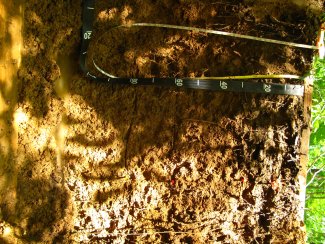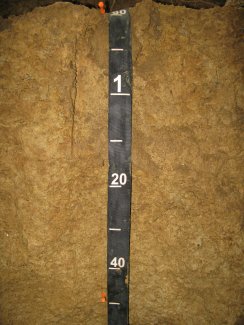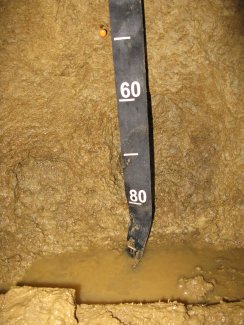Dead Lake NEON (DELA) Soil Descriptions
Distributed Soils Reports
Pedon Descriptions
Pit‐level observations and field measurements reported using the standard NRCS format. They contain volume estimates for coarse fragments > 20 mm where applicable.
Site Level Plot Summary
A narrative summary that places the sampled soil pedons in the broader context of soils and geomorphology for the entire NEON site.
Megapit Images

D08 DELA megapit soil profile 0-100 cm

D08 DELA megapit soil profile 80-155 cm

D08 DELA megapit soil profile 145-191 cm
Megapit Pedon Description
| Print Date | Jul 22 2015 |
|---|---|
| Description Date | Apr 29 2013 |
| Describer | Lawrence McGhee |
| Site ID | S2013AL063001 |
| Pedon ID | S2013AL063001 |
| Lab Source ID | SSL |
| Lab Pedon # | 13N49390 |
| Soil Name as Described/Sampled | Angie |
| Classification | Fine, mixed, semiactive, thermic Aquic Paleudults |
| Pedon Type | confirmation description |
| Pedon Purpose | research site |
| Taxon Kind | series |
| Geomorphic Setting | microhigh on toeslope of tread of flood plain |
| Upslope Shape | linear |
| Cross Slope Shape | linear |
| Particle Size Control Section | 27 to 77 cm. |
| Description origin | NASIS |
| Country | United States |
| State | Alabama |
| County | Greene |
| MLRA | 133A -- Southern Coastal Plain |
| Soil Survey Area | AL063 -- Greene County, Alabama |
| Quad Name | Demopolis, Alabama |
| Std Latitude | 32.5410000 |
| Std Longitude | -87.8031667 |
| Latitude | 32 degrees 32 minutes 27.60 seconds north |
| Longitude | 87 degrees 48 minutes 11.40 seconds west |
| Datum | NAD83 |
| UTM Zone | 16 |
| UTM Easting | 424584 meters |
| UTM Northing | 3600688 meters |
| Primary Earth Cover | Tree cover |
| Parent Material | Fine textured alluvium and marine sediments |
| Description database | KSSL |
| Diagnostic Features | argillic horizon 27 to 200 cm. |
| Slope (%) | 0.5 |
| Elevation (meters) | 22.8 |
| MAAT (C) | 18.1 |
| MAP (mm) | 1,440 |
| Frost-Free Days | 236 |
| Drainage Class | moderately well |
| Horizon Details |
Oi--0 to 2 centimeters (0.0 to 0.8 inches); herbaceous; . Lab sample # 13N04852 A1--2 to 15 centimeters (0.8 to 5.9 inches); dark grayish brown (10YR 4/2) loam; weak coarse subangular blocky structure; firm; medium roots throughout and coarse roots throughout; noneffervescent; slightly acid, pH 6.5, pH indicator solutions; clear smooth boundary. Lab sample # 13N04853 A2--15 to 27 centimeters (5.9 to 10.6 inches); very dark grayish brown (10YR 3/2) broken face loam; moderate medium granular structure; friable; medium roots throughout and coarse roots throughout; noneffervescent; slightly acid, pH 6.5, pH indicator solutions; clear wavy boundary. Lab sample # 13N04854 Bt1--27 to 58 centimeters (10.6 to 22.8 inches); dark yellowish brown (10YR 4/6) broken face silty clay loam; weak fine subangular blocky structure; friable; medium roots throughout and fine roots between peds; faint clay films on all faces of peds; 10 percent fine distinct iron depletions with diffuse boundaries in cracks; 15 percent fine distinct cylindrical weakly cemented ferromagnesian minerals with clear boundaries in matrix; noneffervescent; very strongly acid, pH 5.0, pH indicator solutions; gradual wavy boundary. Lab sample # 13N04855 Bt2--58 to 79 centimeters (22.8 to 31.1 inches); yellowish brown (10YR 5/6) broken face silty clay loam; moderate fine subangular blocky structure; firm; medium roots between peds and fine roots between peds; faint clay films on all faces of peds; 10 percent medium distinct iron depletions with clear boundaries between peds; 15 percent medium distinct cylindrical weakly cemented ferromagnesian minerals with clear boundaries in matrix; noneffervescent; very strongly acid, pH 5.0, pH indicator solutions; gradual wavy boundary. Lab sample # 13N04856 Bt3--79 to 150 centimeters (31.1 to 59.1 inches); dark yellowish brown (10YR 4/6) broken face silty clay loam; moderate medium subangular blocky, and weak fine subangular blocky structure; firm; medium roots between peds and fine roots between peds; distinct clay films on all faces of peds; 20 percent medium distinct iron depletions with clear boundaries infused into matrix along faces of peds; 5 percent fine distinct cylindrical moderately cemented ferromagnesian minerals with clear boundaries in matrix and 30 percent medium distinct irregular weakly cemented ferromagnesian minerals with clear boundaries in matrix; noneffervescent; very strongly acid, pH 5.0, pH indicator solutions; gradual wavy boundary. Lab sample # 13N04857 Bt4--150 to 200 centimeters (59.1 to 78.7 inches); 40 percent yellowish brown (10YR 5/6) broken face silty clay loam; weak coarse subangular blocky structure; firm; fine roots between peds; distinct clay films on vertical faces of peds; 8 percent medium distinct cylindrical weakly cemented plinthite nodules with clear boundaries throughout and 25 percent fine distinct iron depletions with clear boundaries throughout and 25 percent fine distinct masses of oxidized iron; 15 percent medium distinct cylindrical weakly cemented ferromagnesian minerals with sharp boundaries in matrix; noneffervescent; very strongly acid, pH 5.0, pH indicator solutions. Lab sample # 13N04858 |
Credits: This megapit soil pedon description was generously created by USDA Natural Resource Conservation Service staff, with particular thanks to Larry West, Jon Hempel, and numerous field staff.